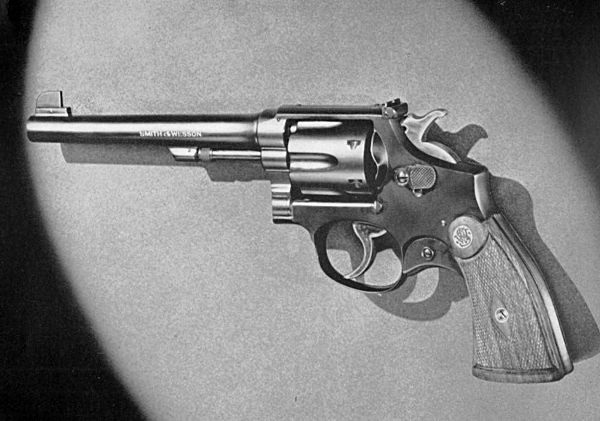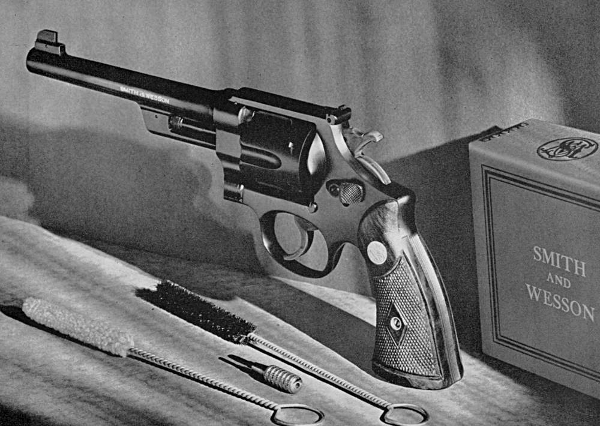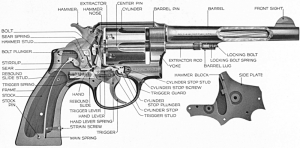The following information on Smith & Wesson arms comes from Burning Powder by Lt. Col. Douglas B. Wesson. Burning Powder is also available to purchase in print.
The proper selection of arms for the various matches is, of course, not only the most important, but one of the most interesting features of the shooting game. It can be said at once that no greater mistake could be made than purchasing an inferior weapon with the idea of economy; it will not only prove more expensive in the long run, but the dissatisfaction of changing trigger pull and failure of parts will remove a great portion of the enjoyment of shooting. It must be realized also, that when one has reached the point in shooting where a certain score is to be expected, an inaccurate arm or the use of inferior ammunition resulting in lower scores than anticipated will do a great deal to destroy confidence, and, in shooting, confidence is essential to success.
Smith & Wesson arms are widely advertised, not by the expenditure of large sums of money in advertising space, but by the finest of all publicity, the enthusiastic praises of the men who shoot them. Smith & Wesson make no claims for their arms that are not substantiated by facts and records; the purchasing of one of their models will not, in all probability, change a fair shooter to an expert over night, but it is a fact that a great number of the existing records in the shooting world were established by users of Smith & Wesson pistols and revolvers. The unequalled quality of workmanship, material and design, characteristic of Smith & Wesson arms, results in the long life and unchanging functioning that is imperative for utmost familiarity with one’s weapon and consequent high scores. When one considers the cost of a good pistol or revolver, and then figures that the accurate life of a properly cared for Smith & Wesson has frequently reached a quarter of a million rounds, it will be readily appreciated that the initial cost of the arm is insignificant compared to the cost of the ammunition used in it. Here, if ever, is a perfect example of the old saying, “The best is the cheapest.”
In the latter part of this book we will describe various types of Smith & Wesson revolvers with a brief statement of what has been accomplished with the different models.
Care Of Arms
It is perfectly true that the better a piece of mechanism is designed and the closer the workmanship, the less attention it will require to keep it in good functioning condition, but it is equally true that the same piece of mechanism with reasonable care and careful handling will continue to give best results for a far longer period.

We have seen revolvers that have been practically ruined from the standpoint of accuracy after having been fired but a few rounds entirely due to lack of attention, while on the other hand we have records of revolvers of our make that have been fired well over a quarter of a million rounds that show in machine rest tests an accuracy equal to that when they were new.
The present day non-corrosive type of ammunition has removed to a great extent the necessity of the old-time painstaking attention after shooting, and it is true that a pistol or a revolver may be fired over a long period of time with this ammunition without requiring any attention to its chambers or rifling, but we cannot afford to assume from this that the arm will be safe from deterioration without care. It is possible, for example, that the firing of two kinds of non-corrosive ammunition will result in the second neutralizing the effects of the first and permitting barrel corrosion, and it is also true that the dry coated bullets, so popular in many parts of the country, tend to form a deposit in the barrel that if left undisturbed will build up and eventually affect the accuracy.
If, as a matter of convenience, dry, greaseless ammunition is used, it is well to keep a close watch on the rifling and chambering, and, at the first signs of the coating depositing, clean it out with a brass or bronze wire brush and any of the nitro-solvents on the market.
It might be of interest to say here that in any Smith & Wesson revolver the .22 Short cartridges can be used with excellent results and with no fear of injury to the rifling or chambering whatsoever. There may be an accumulation of burnt powder form on the chamber walls directly ahead of the short shells that would tend to make extraction somewhat difficult when again using the longer ones, but this can be readily removed as in the case with the deposit from the greaseless bullets. The chamber walls, owing to the patented burnishing process they undergo, will remain unaffected.

After shooting it is an excellent idea to swab the barrel out with a soft clean patch (flannelette or flannel being the best) using a brass or hickory rod, and after so-doing scrub the barrel and chambers briskly with a bristle brush or wool wiper dipped in any of the nitro-solvents available. Care should be taken in seeing that the soft twisted wire handle of the brush or wiper is not permitted to come in unduly severe contact with the muzzle of the arm as this may result in injury to the ends of the lands or grooves; it is really amazing to find out how seriously the accuracy of an arm can be affected by an almost microscopic injury to the rifling at this point.
After cleaning the barrel and chambers of the arm, as described above, it is well to wipe the entire outer surface of the arm with a cloth moistened with any of the standard brands of gun oil on the market; this is particularly important in damp, humid weather as the blue finish, in almost universal use by the target shooters, is not in itself a protection against rust. It is not uncommon to find a shooter whose perspiration carries such a tremendous amount of acid that unless the arm is wiped off as described it will begin to show rust within an hour.
While, of course, the action of a pistol or a revolver requires a certain amount of lubrication, it will be found that with an arm cared for as described, enough oil will find its way into the lock work so that it will require no attention for many years. Should it be desired for any reason to remove the side plate, this can be easily accomplished in the following manner:
First—Remove the screws holding the stocks in place, and take off the stocks.
Second—Take out the four screws holding the side plate in place, using a screwdriver of correct size. Then, holding the revolver flat in the left hand, side plate on top, strike the tang a few sharp blows with a piece of wood which has been covered with a soft cloth. This will loosen the side plate which can then be lifted off; (do not attempt to pry the side plate as the frame will certainly be marred). When it has been removed, clean the mechanism with a soft cloth moistened with nitro-solvent. Then dry, and place a few drops of high grade gun oil on the working points by means of a toothpick or match. Replace the side plate carefully.

A highly important point is to procure screwdrivers with blades that fit the slots in the screws accurately; this is the only way that you can be assured of removing the screws without marring them or the side plate. Nothing is more painful to the lover of fine workmanship than to have a screwdriver slip from a slot, due to its poor fit, and, as almost invariably occurs, scratch or mar the surface of the frame or side plate.
